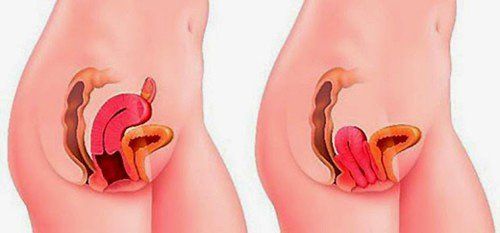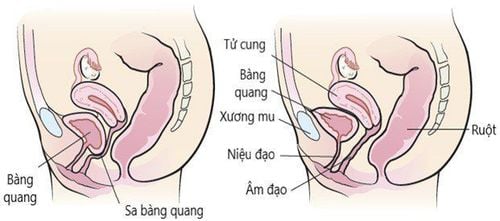This is an automatically translated article.
Uterine ligament shortening surgery is a method of preserving the uterus for women during childbirth. Surgery is performed to correct the weakening of the uterine ligaments, helping to lift the uterus without much dependence on the ligament's activity.1. What is genital prolapse?
Genital prolapse, also known as pelvic organ prolapse, is a condition in which the uterus, bladder, rectum, anterior and posterior vaginal walls are retracted from the normal anatomical position due to ligamentous structures. , the fascia that supports the pelvic floor is damaged or weakened.The system to support the organs in the pelvis includes:
The support system includes the levator anal muscle, the superficial muscle of the vocal chord floor The ligament system, the mesentery includes the dorsal ligaments of the urethra, the fascia of the neck. uterus, utero-sacral ligament, transverse cervical ligament, Halban fascia, rectovaginal fascia. The system of orientation includes round and broad ligaments Genitourinary tract prolapse is the most common uterine prolapse, depending on the severity, the uterus can prolapse from the vagina to the outside of the vulva. The disease is common in women who give birth a lot, often work hard and have difficulties during childbirth.

Sa sinh dục gặp nhiều nhất là sa tử cung
2. Symptoms of genital prolapse
Genital prolapse progresses slowly to very slowly from 5 to 20 years, the longer it is left untreated, the worse the degree of pelvic organ prolapse will be. Patients can prolapse from one organ to many organs at the same time. Mild genital prolapse is often asymptomatic or mild symptoms go unnoticed by the patient. Severe genital prolapse has symptoms of discomfort or heaviness in the lower abdomen, urinary frequency, urinary incontinence, urinary incontinence, sometimes difficult defecation.When the pelvic area is examined, it is often found that prolapse is located in the lower 1/2 of the vagina, the most severe case is a prolapsed mass protruding from the vulva, this prolapse may be keratinized, ulcerated by rubbing or superinfection.
To make sure you don't have cancer, a Pap smear may be ordered. In addition, the patient was also tested for urodynamics to look at urinary incontinence.
3. Treatment of pelvic organ prolapse by shortening the uterine ligament
The surgery to shorten the uterine ligament is also known as the Shirodkar surgery. This is a surgical method to preserve the uterus. The surgery is performed by shortening the utero-sacral ligament and attaching it to the anterior isthmus of the uterus.Shirodkar surgery is applied mainly to young women who have never given birth, women with grade II genital prolapse.
4. Other uterine-conserving surgical measures in the treatment of rectal prolapse

Phương pháp Manchester được chỉ định cho phụ nữ trẻ, chưa sinh con hoặc đang mong muốn có con
Young women who have not given birth or are trying to have children Elderly women with grade III genital prolapse who cannot tolerate major surgery Surgery Surgery is performed in the following order:
Cervical amputation Surgeon Shortening of the transverse uterine ligament Mackenrodt Bladder lift Restoration of the anterior vaginal wall Using Sturmdorft sutures to restore the neck Uterus Reconstruction of the posterior uterine wall 4.2 Crossen method The method is indicated for women of all ages with grade III genital prolapse with a non-ulcerative cervix.
Crossen surgery is performed in turn through the following steps:
Total hysterectomy through the vagina Cross binding of Mackenrodt transverse uterine ligaments and round ligaments combined with sutures to form a strong hammock, against intestinal prolapse. Perform a bladder lift Suture Restore anterior vaginal wall Sew anal levator muscle and restore posterior vaginal wall
5. What happens when pelvic organ prolapse is not treated?
Pelvic organ prolapse (genital prolapse) often gets worse over time, and it rarely heals on its own. In mild cases, the disease is almost asymptomatic. Only when the mass prolapses into the vagina and vulva, the disease begins to manifest as discomfort, affecting the patient's quality of life.If not treated early, the disease worsens and causes many complications such as ulcerative prolapse, cervical ulcer, urinary tract infection.
6. Prevention of genital prolapse

Để phòng bệnh sa sinh dục cần tránh sinh con ở tuổi quá trẻ hoặc sinh con dày 1-2 năm
Avoid giving birth at a very young age, giving birth to many children, giving birth 1-2 years thick During the reproductive period , do not go into labor for too long Have a safe birth at medical facilities Have a reasonable maternity leave time, avoid heavy work, and overwork after 3 - 6 months In addition, if there are injuries Genital tract injuries such as infections, tumors need to be treated immediately. Avoid causing increased intra-abdominal pressure by treating constipation, cough if the condition persists.
Vinmec International General Hospital implements methods of treating pelvic organ prolapse with outstanding advantages:
Experienced doctors in Obstetrics and Gynecology surgery. Modern equipment, high treatment efficiency. Professional services: Modern civilized disease prevention system, comprehensive care, meals, rest, exercise, health education, each room is equipped with amenities like a hotel apartment 5 stars, patient information is confidential. Hybrid operating room is the most modern operating room system in the world today, integrating operating room and advanced imaging equipment (CT scan, MRI, ultrasound...) to help reduce surgery time. and bring the best surgical effect to the patient. In anesthesia resuscitation, Vinmec adheres to anesthetic protocols, anesthesia safety guidelines, anesthesia checklists for 100% of surgeries to minimize incidents and unwanted effects.
Please dial HOTLINE for more information or register for an appointment HERE. Download MyVinmec app to make appointments faster and to manage your bookings easily.













